SOLIQUA 100/33- insulin glargine and lixisenatide injection, solution
Soliqua 100/33 by
Drug Labeling and Warnings
Soliqua 100/33 by is a Prescription medication manufactured, distributed, or labeled by Sanofi-Aventis U.S. LLC, Sanofi-Aventis Deutschland GmbH. Drug facts, warnings, and ingredients follow.
Drug Details [pdf]
-
HIGHLIGHTS OF PRESCRIBING INFORMATION
These highlights do not include all the information needed to use SOLIQUA 100/33 safely and effectively. See full prescribing information for SOLIQUA 100/33.
SOLIQUA® 100/33 (insulin glargine and lixisenatide injection), for subcutaneous use
Initial U.S. Approval: 2016RECENT MAJOR CHANGES
INDICATIONS AND USAGE
SOLIQUA 100/33 is a combination of a long-acting human insulin analog with a glucagon-like peptide-1 (GLP-1) receptor agonist indicated as an adjunct to diet and exercise to improve glycemic control in adults with type 2 diabetes mellitus. (1)
Limitations of Use (1):
- Has not been studied in patients with a history of pancreatitis. Consider other antidiabetic therapies in patients with a history of pancreatitis.
- Not recommended for use in combination with any other product containing a GLP-1 receptor agonist.
- Not for treatment of type 1 diabetes mellitus or diabetic ketoacidosis.
- Not recommended for use in patients with gastroparesis.
- Has not been studied in combination with prandial insulin.
DOSAGE AND ADMINISTRATION
- Inject subcutaneously once a day within the hour prior to the first meal of the day. (2.1)
- SOLIQUA 100/33 pen delivers 15 units to 60 units per injection. (2.1, 2.2)
- Maximum daily dosage is 60 units (60 units of insulin glargine and 20 mcg of lixisenatide). (2.1)
- Discontinue basal insulin or GLP-1 receptor agonist prior to initiation. (2.2)
- In patients naive to basal insulin or to a GLP-1 receptor agonist, currently on less than 30 units of basal insulin, or on a GLP-1 receptor agonist, the recommended starting dosage is 15 units subcutaneously once daily. (2.2)
- In patients inadequately controlled on 30 to 60 units of basal insulin, the starting dosage is 30 units subcutaneously once daily. (2.2)
- See Full Prescribing Information for titration recommendations. (2.3)
- Inject subcutaneously in abdominal area, thigh, or upper arm and rotate injection sites within the same region from one injection to the next to reduce risk of lipodystrophy and localized cutaneous amyloidosis. (2.5)
- Do not administer intravenously, intramuscularly, or by an infusion pump. (2.5)
- Do not dilute or mix with any other insulin products or solutions. (2.5)
DOSAGE FORMS AND STRENGTHS
Injection: 100 units of insulin glargine per mL and 33 mcg of lixisenatide per mL in a 3 mL single-patient-use pen. (3)
CONTRAINDICATIONS
WARNINGS AND PRECAUTIONS
- Anaphylaxis and serious hypersensitivity reactions: Severe, life-threatening, and generalized allergic reactions can occur. Instruct patients to discontinue use if a reaction occurs and promptly seek medical attention. (5.1)
- Pancreatitis: Discontinue promptly if pancreatitis is suspected. Do not restart if pancreatitis is confirmed. (5.2)
- Never share a SOLIQUA 100/33 prefilled pen between patients, even if the needle is changed. (5.3)
- Hyperglycemia or hypoglycemia with changes in insulin regimen: Make changes to a patient's insulin regimen (e.g., insulin strength, manufacturer, type, injection site or method of administration) under close medical supervision with increased frequency of blood glucose monitoring. (5.4)
- Overdose due to medication errors: SOLIQUA 100/33 contains two drugs. Instruct patients to always check the label before each injection since accidental mix-ups with insulin-containing products can occur. Do not exceed the maximum dose or use with other GLP-1 receptor agonists. (5.5)
- Hypoglycemia: May be life-threatening. Increase frequency of glucose monitoring with changes to: insulin dosage, coadministered glucose lowering medications, meal pattern, physical activity; and in patients with renal or hepatic impairment and hypoglycemia unawareness. (5.6)
- Acute kidney injury: Monitor renal function in patients with renal impairment and in patients with severe GI adverse reactions. Use is not recommended in patients with end-stage renal disease. (5.7)
- Immunogenicity: Patients may develop antibodies to insulin glargine and lixisenatide. If there is worsening glycemic control or failure to achieve targeted glycemic control, significant injection-site reactions or allergic reactions, alternative antidiabetic therapy should be considered. (5.8)
- Hypokalemia: May be life-threatening. Monitor potassium levels in patients at risk of hypokalemia and treat if indicated. (5.9)
- Fluid retention and heart failure with use of thiazolidinediones (TZDs): Observe for signs and symptoms of heart failure; consider dosage reduction or discontinuation if heart failure occurs. (5.10)
- Macrovascular outcomes: Clinical studies have not shown macrovascular risk reduction with SOLIQUA 100/33. (5.11)
ADVERSE REACTIONS
The most common adverse reactions, reported in ≥5% of patients treated with SOLIQUA 100/33 include hypoglycemia, nausea, nasopharyngitis, diarrhea, upper respiratory tract infection, and headache. (6.1)
To report SUSPECTED ADVERSE REACTIONS, contact sanofi-aventis at 1-800-633-1610 or FDA at 1-800-FDA-1088 or www.fda.gov/medwatch.
DRUG INTERACTIONS
- Drugs that affect glucose metabolism: Adjustment of SOLIQUA 100/33 dosage may be needed; closely monitor blood glucose. (7.1)
- Antiadrenergic Drugs (e.g., beta-blockers, clonidine, guanethidine, and reserpine): Hypoglycemia signs and symptoms may be reduced. (7.1)
- Effects of delayed gastric emptying on oral medications: Lixisenatide delays gastric emptying which may impact absorption of concomitantly administered oral medications. Oral contraceptives and other medications such as antibiotics and acetaminophen should be taken at least 1 hour prior to SOLIQUA 100/33 administration or 11 hours after. (7.2)
USE IN SPECIFIC POPULATIONS
- Pregnancy: SOLIQUA 100/33 should be used during pregnancy only if the potential benefit justifies the potential risk to the fetus. (8.1)
See 17 for PATIENT COUNSELING INFORMATION and Medication Guide.
Revised: 11/2019
-
Table of Contents
FULL PRESCRIBING INFORMATION: CONTENTS*
1 INDICATIONS AND USAGE
2 DOSAGE AND ADMINISTRATION
2.1 Important Dosage Information
2.2 Recommended Starting Dose
2.3 Titration of SOLIQUA 100/33
2.4 Missed Doses
2.5 Important Administration Instructions
3 DOSAGE FORMS AND STRENGTHS
4 CONTRAINDICATIONS
5 WARNINGS AND PRECAUTIONS
5.1 Anaphylaxis and Serious Hypersensitivity Reactions
5.2 Pancreatitis
5.3 Never Share a SOLIQUA 100/33 Prefilled Pen Between Patients
5.4 Hyperglycemia or Hypoglycemia with Changes in Insulin Regimen
5.5 Overdose Due to Medication Errors
5.6 Hypoglycemia
5.7 Acute Kidney Injury
5.8 Immunogenicity
5.9 Hypokalemia
5.10 Fluid Retention and Heart Failure with Concomitant Use of PPAR-gamma Agonists
5.11 Macrovascular Outcomes
6 ADVERSE REACTIONS
6.1 Clinical Trials Experience
6.2 Immunogenicity
6.3 Postmarketing Experience
7 DRUG INTERACTIONS
7.1 Medications that Can Affect Glucose Metabolism
7.2 Effects of Delayed Gastric Emptying on Oral Medications
8 USE IN SPECIFIC POPULATIONS
8.1 Pregnancy
8.2 Lactation
8.4 Pediatric Use
8.5 Geriatric Use
8.6 Renal Impairment
8.7 Hepatic Impairment
8.8 Patients with Gastroparesis
10 OVERDOSAGE
11 DESCRIPTION
12 CLINICAL PHARMACOLOGY
12.1 Mechanism of Action
12.2 Pharmacodynamics
12.3 Pharmacokinetics
13 NONCLINICAL TOXICOLOGY
13.1 Carcinogenesis, Mutagenesis, Impairment of Fertility
14 CLINICAL STUDIES
14.1 Overview of Clinical Studies
14.2 Clinical Study in Patients with Type 2 Diabetes Uncontrolled on OAD Treatment
14.3 Clinical Studies in Patients with Type 2 Diabetes Uncontrolled on Basal Insulin
16 HOW SUPPLIED/STORAGE AND HANDLING
16.1 How Supplied
16.2 Storage
17 PATIENT COUNSELING INFORMATION
- * Sections or subsections omitted from the full prescribing information are not listed.
-
1 INDICATIONS AND USAGE
SOLIQUA 100/33 is a combination of insulin glargine and lixisenatide and is indicated as an adjunct to diet and exercise to improve glycemic control in adults with type 2 diabetes mellitus.
Limitations of Use:
- SOLIQUA 100/33 has not been studied in patients with a history of pancreatitis [see Warnings and Precautions (5.2)]. Consider other antidiabetic therapies in patients with a history of pancreatitis.
- SOLIQUA 100/33 is not recommended for use in combination with any other product containing a GLP-1 receptor agonist [see Warnings and Precautions (5.5)].
- SOLIQUA 100/33 is not indicated for use in patients with type 1 diabetes mellitus or for the treatment of diabetic ketoacidosis.
- SOLIQUA 100/33 has not been studied in patients with gastroparesis and is not recommended in patients with gastroparesis.
- SOLIQUA 100/33 has not been studied in combination with prandial insulin.
-
2 DOSAGE AND ADMINISTRATION
2.1 Important Dosage Information
- SOLIQUA 100/33 is a combination of insulin glargine and lixisenatide.
- Administer SOLIQUA 100/33 subcutaneously once a day within the hour prior to the first meal of the day.
- The SOLIQUA 100/33 pen delivers doses from 15 to 60 units in a single injection. Table 1 presents the units of insulin glargine and the micrograms of lixisenatide in each dosage of SOLIQUA 100/33 [see Dosage and Administration (2.2)].
- The maximum dose of SOLIQUA 100/33 is 60 units daily (60 units insulin glargine/20 mcg lixisenatide) [see Warnings and Precautions (5.5)].
2.2 Recommended Starting Dose
In patients naive to basal insulin or to a GLP-1 receptor agonist, currently on a GLP-1 receptor agonist or currently on less than 30 units of basal insulin daily:
- Discontinue therapy with basal insulin or a GLP-1 receptor agonist prior to initiation of SOLIQUA 100/33.
- The recommended starting dosage of SOLIQUA 100/33 is 15 units (15 units insulin glargine/5 mcg lixisenatide) given subcutaneously once daily.
In patients currently on 30 to 60 units of basal insulin daily, with or without a GLP-1 receptor agonist:
- Discontinue therapy with basal insulin or GLP-1 receptor agonist prior to initiation of SOLIQUA 100/33.
- The recommended starting dosage of SOLIQUA 100/33 is 30 units (30 units insulin glargine/10 mcg lixisenatide) given subcutaneously once daily.
Table 1: Units of Insulin Glargine and Micrograms of Lixisenatide in Each Dosage of SOLIQUA 100/33 SOLIQUA 100/33
(dose window display)*Insulin glargine component dose Lixisenatide component dose Comment - * The dose window on the SOLIQUA 100/33 pen displays numbers for the even units and displays lines for the odd units.
2 --- --- Safety test dose – not for injection 15 15 units 5 mcg Recommended starting dosage for patients naive to basal insulin or GLP-1 receptor agonist, currently on GLP-1 receptor agonist, or currently on less than 30 units of basal insulin daily 16 16 units 5.3 mcg 17 17 units 5.7 mcg 18 18 units 6 mcg 19 19 units 6.3 mcg 20 20 units 6.7 mcg 21 21 units 7 mcg 22 22 units 7.3 mcg 23 23 units 7.7 mcg 24 24 units 8 mcg 25 25 units 8.3 mcg 26 26 units 8.7 mcg 27 27 units 9 mcg 28 28 units 9.3 mcg 29 29 units 9.7 mcg 30 30 units 10 mcg Recommended starting dosage for patients currently on 30 to 60 units of basal insulin daily, with or without a GLP-1 receptor agonist: 31 31 units 10.3 mcg 32 32 units 10.7 mcg 33 33 units 11 mcg 34 34 units 11.3 mcg 35 35 units 11.7 mcg 36 36 units 12 mcg 37 37 units 12.3 mcg 38 38 units 12.7 mcg 39 39 units 13 mcg 40 40 units 13.3 mcg 41 41 units 13.7 mcg 42 42 units 14 mcg 43 43 units 14.3 mcg 44 44 units 14.7 mcg 45 45 units 15 mcg 46 46 units 15.3 mcg 47 47 units 15.7 mcg 48 48 units 16 mcg 49 49 units 16.3 mcg 50 50 units 16.7 mcg 51 51 units 17 mcg 52 52 units 17.3 mcg 53 53 units 17.7 mcg 54 54 units 18 mcg 55 55 units 18.3 mcg 56 56 units 18.7 mcg 57 57 units 19 mcg 58 58 units 19.3 mcg 59 59 units 19.7 mcg 60 60 units 20 mcg Maximum daily dosage [see Warnings and Precautions (5.5)] 2.3 Titration of SOLIQUA 100/33
- After starting with the recommended dosage of SOLIQUA 100/33, [see Dosage and Administration (2.2)], titrate the dosage upwards or downwards by two to four units (see Table 2) every week based on the patient's metabolic needs, blood glucose monitoring results, and glycemic control goal until the desired fasting plasma glucose is achieved.
- To minimize the risk of hypoglycemia or hyperglycemia, additional titration may be needed with changes in physical activity, meal patterns (i.e., macronutrient content or timing of food intake), or renal or hepatic function; during acute illness; or when used with other medications [see Warnings and Precautions (5.4) and Drug Interactions (7)].
Table 2: Recommended Titration of SOLIQUA 100/33 (Every Week)* Self-Monitored Fasting Plasma Glucose SOLIQUA 100/33 Dosage Adjustment - * The recommended SOLIQUA 100/33 dosage is between 15 to 60 units (see Table 1).
Above target range +2 units (2 units of insulin glargine and 0.66 mcg of lixisenatide) to +4 units (4 units insulin glargine and 1.32 mcg lixisenatide) Within target range 0 units Below target range -2 units (2 units of insulin glargine and 0.66 mcg of lixisenatide) to -4 units (4 units of insulin glargine and 1.32 mcg lixisenatide) 2.4 Missed Doses
Instruct patients who miss a dose of SOLIQUA 100/33 to resume the once-daily regimen as prescribed with the next scheduled dose. Do not administer an extra dose or increase the dose to make up for the missed dose.
2.5 Important Administration Instructions
- The SOLIQUA 100/33 prefilled pen is for single-patient-use only [see Warnings and Precautions (5.3)].
- Train patients on proper use and injection technique before initiating SOLIQUA 100/33.
- Always check the SOLIQUA 100/33 label before administration [see Warnings and Precautions (5.5)].
- Visually inspect for particulate matter and discoloration prior to administration. Only use SOLIQUA 100/33 if the solution is clear and colorless to almost colorless.
- Inject SOLIQUA 100/33 subcutaneously into the abdominal area, thigh, or upper arm.
- Rotate injection sites within the same region from one injection to the next to reduce the risk of lipodystrophy and localized cutaneous amyloidosis. Do not inject into areas of lipodystrophy or localized cutaneous amyloidosis [see Warnings and Precautions (5.2), Adverse Reactions (6)].
- During changes to a patient's insulin regimen, increase the frequency of blood glucose monitoring [see Warnings and Precautions (5.4)].
- Do not administer intravenously, intramuscularly, or via an insulin pump.
- Use SOLIQUA 100/33 with caution in patients with visual impairment who may rely on audible clicks to dial their dose.
- The SOLIQUA 100/33 pen dials in 1 unit increments.
- Do not dilute or mix SOLIQUA 100/33 with any other insulin or solution.
- Do not split the dose of SOLIQUA 100/33.
- 3 DOSAGE FORMS AND STRENGTHS
-
4 CONTRAINDICATIONS
SOLIQUA 100/33 is contraindicated:
- During episodes of hypoglycemia [see Warnings and Precautions (5.6)].
- In patients with hypersensitivity to SOLIQUA 100/33, either of the active drug substances (insulin glargine or lixisenatide), or any of its excipients. Hypersensitivity reactions including anaphylaxis have occurred with both lixisenatide and insulin glargine [see Warnings and Precautions (5.1) and Adverse Reactions (6.1)].
-
5 WARNINGS AND PRECAUTIONS
5.1 Anaphylaxis and Serious Hypersensitivity Reactions
In clinical trials of lixisenatide, a component of SOLIQUA 100/33, there have been cases of anaphylaxis (frequency of 0.1% or 10 cases per 10,000 patient-years) and other serious hypersensitivity reactions including angioedema. Severe, life-threatening, generalized allergic reactions, including anaphylaxis, generalized skin reactions, angioedema, bronchospasm, hypotension, and shock can occur with insulins, including insulin glargine, a component of SOLIQUA 100/33 [see Adverse Reactions (6.1)].
Inform and closely monitor patients with a history of anaphylaxis or angioedema with another GLP-1 receptor agonist for allergic reactions, because it is unknown whether such patients will be predisposed to anaphylaxis with lixisenatide. SOLIQUA 100/33 is contraindicated in patients with known hypersensitivity to lixisenatide or insulin glargine [see Contraindications (4)]. If a hypersensitivity reaction occurs, the patient should discontinue SOLIQUA 100/33 and promptly seek medical attention.
5.2 Pancreatitis
Acute pancreatitis, including fatal and non-fatal hemorrhagic or necrotizing pancreatitis, has been reported postmarketing in patients treated with GLP-1 receptor agonists. In clinical trials of lixisenatide, a component of SOLIQUA 100/33, there were 21 cases of pancreatitis among lixisenatide-treated patients and 14 cases in comparator-treated patients (incidence rate of 21 vs 17 per 10,000 patient-years). Lixisenatide cases were reported as acute pancreatitis (n=3), pancreatitis (n=12), chronic pancreatitis (n=5), and edematous pancreatitis (n=1). Some patients had risk factors for pancreatitis, such as a history of cholelithiasis or alcohol abuse.
After initiation of SOLIQUA 100/33, observe patients carefully for signs and symptoms of pancreatitis (including persistent severe abdominal pain, sometimes radiating to the back and which may or may not be accompanied by vomiting). If pancreatitis is suspected, promptly discontinue SOLIQUA 100/33 and initiate appropriate management. If pancreatitis is confirmed, restarting SOLIQUA 100/33 is not recommended. Consider antidiabetic therapies other than SOLIQUA 100/33 in patients with a history of pancreatitis.
5.3 Never Share a SOLIQUA 100/33 Prefilled Pen Between Patients
SOLIQUA 100/33 prefilled pens must never be shared between patients, even if the needle is changed. Sharing of the pen poses a risk for transmission of blood-borne pathogens.
5.4 Hyperglycemia or Hypoglycemia with Changes in Insulin Regimen
Changes in insulin regimen (e.g., insulin strength, manufacturer, type, injection site or method of administration) may affect glycemic control and predispose to hypoglycemia [see Warnings and Precautions (5.6)] or hyperglycemia. Repeated insulin injections into areas of lipodystrophy or localized cutaneous amyloidosis have been reported to result in hyperglycemia; and a sudden change in the injection site (to unaffected area) has been reported to result in hypoglycemia [see Adverse Reactions (6.)].
Make any changes to a patient's insulin regimen under close medical supervision with increased frequency of blood glucose monitoring. Advise patients who have repeatedly injected into areas of lipodystrophy or localized cutaneous amyloidosis to change the injection site to unaffected areas and closely monitor for hypoglycemia. Adjustments in concomitant oral antidiabetic treatment may be needed. When converting from basal insulin therapy or a GLP-1 receptor agonist to SOLIQUA 100/33 follow dosing recommendations [see Dosage and Administration (2.2, 2.3)].
5.5 Overdose Due to Medication Errors
SOLIQUA 100/33 contains two drugs: insulin glargine and lixisenatide. Administration of more than 60 units of SOLIQUA 100/33 daily can result in overdose of the lixisenatide component. Do not exceed the 20 mcg maximum recommended dose of lixisenatide or use with other glucagon-like peptide-1 receptor agonists.
Accidental mix-ups between insulin products have been reported. To avoid medication errors between SOLIQUA 100/33 (an insulin-containing product) and other insulins, instruct patients to always check the insulin label before each injection.
5.6 Hypoglycemia
Hypoglycemia is the most common adverse reaction associated with insulin-containing products, including SOLIQUA 100/33 [see Adverse Reactions (6.1)]. Severe hypoglycemia can cause seizures, may be life-threatening or cause death. Hypoglycemia can impair concentration ability and reaction time; this may place an individual and others at risk in situations where these abilities are important (e.g., driving or operating other machinery). SOLIQUA 100/33 (an insulin-containing product), or any insulin, should not be used during episodes of hypoglycemia [see Contraindications (4)].
Hypoglycemia can happen suddenly and symptoms may differ in each individual and change over time in the same individual. Symptomatic awareness of hypoglycemia may be less pronounced in patients with longstanding diabetes, in patients with diabetic nerve disease, in patients using medications that block the sympathetic nervous system (e.g., beta-blockers) [see Drug Interactions (7.1)], or in patients who experience recurrent hypoglycemia.
Risk Factors for Hypoglycemia
The risk of hypoglycemia generally increases with intensity of glycemic control. The risk of hypoglycemia after an injection is related to the duration of action of the insulin and, in general, is highest when the glucose lowering effect of the insulin is maximal. As with all insulin-containing preparations, the glucose lowering effect time course of SOLIQUA 100/33 may vary in different individuals or at different times in the same individual and depends on many conditions, including the area of injection as well as the injection-site blood supply and temperature [see Clinical Pharmacology (12.2)].
Other factors which may increase the risk of hypoglycemia include changes in meal pattern (e.g., macronutrient content or timing of meals), changes in level of physical activity, or changes to coadministered medication [see Drug Interactions (7.1)]. Patients with renal or hepatic impairment may be at higher risk of hypoglycemia [see Use in Specific Populations (8.6, 8.7)].
Risk Mitigation Strategies for Hypoglycemia
Patients and caregivers must be educated to recognize and manage hypoglycemia. Self-monitoring of blood glucose plays an essential role in the prevention and management of hypoglycemia. In patients at higher risk for hypoglycemia and patients who have reduced symptomatic awareness of hypoglycemia, increased frequency of blood glucose monitoring is recommended.
The long-acting effect of the insulin glargine component of SOLIQUA 100/33 may delay recovery from hypoglycemia.
5.7 Acute Kidney Injury
Acute kidney injury and worsening of chronic renal failure, which may sometimes require hemodialysis, has been reported postmarketing in patients treated with GLP-1 receptor agonists, such as lixisenatide, a component of SOLIQUA 100/33. Some of these events were reported in patients without known underlying renal disease. A majority of the reported events occurred in patients who had experienced nausea, vomiting, diarrhea, or dehydration.
Monitor renal function when initiating or escalating doses of SOLIQUA 100/33 in patients with renal impairment and in patients reporting severe gastrointestinal reactions. Advise patients of the potential risk of dehydration due to gastrointestinal adverse reactions and take precautions to avoid fluid depletion. SOLIQUA 100/33 is not recommended in patients with end-stage renal disease [see Use in Specific Populations (8.6)].
5.8 Immunogenicity
Patients may develop antibodies to insulin and lixisenatide, components of SOLIQUA 100/33, following treatment. A pooled analysis of studies of lixisenatide-treated patients showed that 70% were antibody positive at Week 24. In the subset of patients (2.4%) with the highest antibody concentrations (>100 nmol/L), an attenuated glycemic response was observed. A higher incidence of allergic reactions and injection-site reactions occurred in antibody positive patients [see Warnings and Precautions (5.1), Adverse Reactions (6.2)].
If there is worsening glycemic control or failure to achieve targeted glycemic control, significant injection-site reactions or allergic reactions, alternative antidiabetic therapy should be considered.
5.9 Hypokalemia
All insulin-containing products, including SOLIQUA 100/33, cause a shift in potassium from the extracellular to intracellular space, possibly leading to hypokalemia. Untreated hypokalemia may cause respiratory paralysis, ventricular arrhythmia, and death. Monitor potassium levels in patients at risk for hypokalemia if indicated (e.g., patients using potassium-lowering medications, patients taking medications sensitive to serum potassium concentrations).
5.10 Fluid Retention and Heart Failure with Concomitant Use of PPAR-gamma Agonists
Thiazolidinediones (TZDs), which are peroxisome proliferator-activated receptor (PPAR)-gamma agonists, can cause dose-related fluid retention, particularly when used in combination with insulin-containing products, including SOLIQUA 100/33. Fluid retention may lead to or exacerbate heart failure. Patients treated with insulin-containing products, including SOLIQUA 100/33, and a PPAR-gamma agonist should be observed for signs and symptoms of heart failure. If heart failure develops, it should be managed according to current standards of care, and discontinuation or dose reduction of the PPAR-gamma agonist must be considered.
-
6 ADVERSE REACTIONS
The following adverse reactions are discussed elsewhere:
- Anaphylaxis and Serious Hypersensitivity Reactions [see Warnings and Precautions (5.1)]
- Pancreatitis [see Warnings and Precautions (5.2)]
- Hypoglycemia [see Warnings and Precautions (5.6)]
- Acute Kidney Injury [see Warnings and Precautions (5.7)]
- Hypokalemia [see Warnings and Precautions (5.9)]
6.1 Clinical Trials Experience
Because clinical trials are conducted under widely varying conditions, adverse reaction rates observed in clinical trials of a drug cannot be directly compared to rates in the clinical trial of another drug and may not reflect the rates observed in practice.
The safety of SOLIQUA 100/33 (n=834, with a mean treatment duration of 203 days) has been evaluated in two clinical studies (30 weeks duration) in type 2 diabetes patients. The studies, Study A and B [see Clinical Studies (14)], had the following characteristics: mean age was approximately 59 years; approximately 50% were male, 90% were Caucasian, 6% were Black or African American, and 18% were Hispanic. The mean duration of diabetes was 10.3 years, mean HbA1c at screening for Study A was 8.2 and Study B was 8.5. The mean BMI at baseline was 32 kg/m2. Baseline eGFR was ≥60 mL/min in 87.2% of the pooled study population and mean baseline eGFR was 83.0 mL/min/1.73 m2.
Table 3: Adverse Reactions Occurring in ≥5% of SOLIQUA 100/33–Treated Patients with Type 2 Diabetes Mellitus from Two Pooled Clinical Trials SOLIQUA 100/33, %
(n=834)Nausea 10.0 Nasopharyngitis 7.0 Diarrhea 7.0 Upper respiratory tract infection 5.5 Headache 5.4 Hypoglycemia
Hypoglycemia is the most commonly observed adverse reaction in patients using insulin, and insulin-containing products including SOLIQUA 100/33 [see Warnings and Precautions (5.6)]. The rates of reported hypoglycemia depend on the definition of hypoglycemia used, diabetes type, insulin dose, intensity of glucose control, background therapies, and other intrinsic and extrinsic patient factors. For these reasons, comparing rates of hypoglycemia in clinical trials for SOLIQUA 100/33 with the incidence of hypoglycemia for other products may be misleading and also, may not be representative of hypoglycemia rates that will occur in clinical practice.
In the SOLIQUA 100/33 program, severe hypoglycemia was defined as an event requiring assistance of another person to actively administer carbohydrate, glucagon, or other resuscitative actions and documented symptomatic hypoglycemia was defined as an event with typical symptoms of hypoglycemia accompanied by a self-monitored plasma glucose value equal to or less than 70 mg/dL (see Table 4).
No clinically important differences in risk of severe hypoglycemia between SOLIQUA 100/33 and comparators were observed in clinical trials.
Table 4: Hypoglycemic Episodes in SOLIQUA-Treated Patients with T2DM SOLIQUA 100/33
Study A
N=469SOLIQUA 100/33
Study B
N=365- * Defined as an event requiring assistance of another person to actively administer carbohydrate, glucagon, or other resuscitative actions.
Severe symptomatic hypoglycemia* (%) 0 1.1 Hypoglycemia (self-monitored plasma glucose <54 mg/dL) (%) 8.1 17.8 Gastrointestinal Adverse Reactions
Gastrointestinal adverse reactions are the most commonly observed adverse reaction in patients using lixisenatide. Gastrointestinal adverse reactions occur more frequently at the beginning of SOLIQUA 100/33 therapy. Gastrointestinal adverse reactions including nausea, diarrhea, vomiting, constipation, dyspepsia, gastritis, abdominal pain, flatulence, gastroesophageal reflux disease, abdominal distension, and decreased appetite have been reported in patients treated with SOLIQUA 100/33.
In Study A, vomiting was 6.4% in the lixisenatide-treated patients versus 3.2% in the SOLIQUA 100/33–treated patients and 1.5% in the insulin glargine–treated patients; nausea was 24% in the lixisenatide-treated patients versus 9.6% in the SOLIQUA 100/33–treated patients, and 3.6% in the insulin glargine–treated patients.
Lipodystrophy
Administration of insulin subcutaneously, including SOLIQUA 100/33, has resulted in lipoatrophy (depression in the skin) or lipohypertrophy (enlargement or thickening of tissue) in some patients [see Dosage and Administration (2.5)].
Anaphylaxis and Hypersensitivity
Lixisenatide
In the lixisenatide development program anaphylaxis cases were adjudicated. Anaphylaxis was defined as a skin or mucosal lesion of acute onset associated with at least 1 other organ system involvement. Symptoms such as hypotension, laryngeal edema or severe bronchospasm could be present but were not required for the case definition. More cases adjudicated as meeting the definition for anaphylaxis occurred in lixisenatide-treated patients (incidence rate of 0.2% or 16 cases per 10,000 patient years) than placebo-treated patient (incidence rate of 0.1% or 7 cases per 10,000 patient years).
Allergic reactions (such as anaphylactic reaction, angioedema, and urticaria) adjudicated as possibly related to the study medication were observed more frequently in lixisenatide-treated patients (0.4%) than placebo-treated patients (0.2%) [see Warnings and Precautions (5.1)].
Injection-Site Reactions
As with any insulin or GLP-1 receptor agonist–containing product, patients taking SOLIQUA 100/33 may experience injection-site reactions, including injection-site hematoma, pain, hemorrhage, erythema, nodules, swelling, discoloration, pruritus, warmth, and injection-site mass. In the clinical program the proportion of injection-site reactions occurring in patients treated with SOLIQUA 100/33 was 1.7%.
Insulin Initiation and Intensification of Glucose Control
Intensification or rapid improvement in glucose control has been associated with a transitory, reversible ophthalmologic refraction disorder, worsening of diabetic retinopathy, and acute painful peripheral neuropathy. However, long-term glycemic control decreases the risk of diabetic retinopathy and neuropathy.
6.2 Immunogenicity
SOLIQUA 100/33
As with all therapeutic proteins, there is potential for immunogenicity. The detection of antibody formation is highly dependent on the sensitivity and specificity of the assay. Additionally, the observed incidence of antibody (including neutralizing antibody) positivity in an assay may be influenced by several factors including assay methodology, sample handling, timing of sample collection, concomitant medications, and underlying disease. For these reasons, comparison of the incidence of antibodies to SOLIQUA 100/33 in the studies described below with the incidence of antibodies in other studies or to other products may be misleading.
After 30 weeks of treatment with SOLIQUA 100/33 in two phase 3 trials, the incidence of formation of anti-insulin glargine antibodies was 21.0% and 26.2%. In approximately 93% of the patients, anti-insulin glargine antibodies showed cross-reactivity to human insulin. The incidence of formation of anti-lixisenatide antibodies was approximately 43%.
Lixisenatide
In the pool of 9 placebo-controlled studies, 70% of patients exposed to lixisenatide tested positive for anti-lixisenatide antibodies during the trials. In the subset of patients (2.4%) with the highest antibody concentrations (>100 nmol/L), an attenuated glycemic response was observed. A higher incidence of allergic reactions and injection-site reactions occurred in antibody positive patients [see Warnings and Precautions (5.8)].
Anti-lixisenatide antibody characterization studies have demonstrated the potential for development of antibodies cross-reactive with endogenous GLP-1 and glucagon, but their incidence has not been fully determined and the clinical significance of these antibodies is not currently known.
No information regarding the presence of neutralizing antibodies is currently available.
6.3 Postmarketing Experience
The following additional adverse reactions have been identified during postapproval use. Because these reactions are reported voluntarily from a population of uncertain size, it is not always possible to reliably estimate their frequency or establish a causal relationship to drug exposure.
Localized cutaneous amyloidosis at the injection site has occurred with insulins. Hyperglycemia has been reported with repeated insulin injections into areas of localized cutaneous amyloidosis; hypoglycemia has been reported with a sudden change to an unaffected injection site.
-
7 DRUG INTERACTIONS
7.1 Medications that Can Affect Glucose Metabolism
A number of medications affect glucose metabolism and may require dose adjustment of SOLIQUA 100/33 and particularly close monitoring.
Drugs That May Increase the Risk of Hypoglycemia Drugs: Antidiabetic agents, ACE inhibitors, angiotensin II receptor blocking agents, disopyramide, fibrates, fluoxetine, monoamine oxidase inhibitors, pentoxifylline, pramlintide, salicylates, somatostatin analogs (e.g., octreotide), and sulfonamide antibiotics. Intervention: Dose reductions and increased frequency of glucose monitoring may be required when SOLIQUA 100/33 is coadministered with these drugs. Drugs That May Decrease the Blood Glucose Lowering Effect of SOLIQUA 100/33 Drugs: Atypical antipsychotics (e.g., olanzapine and clozapine), corticosteroids, danazol, diuretics, estrogens, glucagon, isoniazid, niacin, oral contraceptives, phenothiazines, progestogens (e.g., in oral contraceptives), protease inhibitors, somatropin, sympathomimetic agents (e.g., albuterol, epinephrine, terbutaline), and thyroid hormones. Intervention: Dose increases and increased frequency of glucose monitoring may be required when SOLIQUA 100/33 is coadministered with these drugs. Drugs That May Increase or Decrease the Blood Glucose Lowering Effect of SOLIQUA 100/33 Drugs: Alcohol, beta-blockers, clonidine, and lithium salts. Pentamidine may cause hypoglycemia, which may sometimes be followed by hyperglycemia. Intervention: Dose adjustment and increased frequency of glucose monitoring may be required when SOLIQUA 100/33 is coadministered with these drugs. Drugs That May Blunt Signs and Symptoms of Hypoglycemia Drugs: Beta-blockers, clonidine, guanethidine, and reserpine. Intervention: Increased frequency of glucose monitoring may be required when SOLIQUA 100/33 is coadministered with these drugs. 7.2 Effects of Delayed Gastric Emptying on Oral Medications
Lixisenatide-containing products, including SOLIQUA 100/33, delay gastric emptying which may reduce the rate of absorption of orally administered medications. Use caution when coadministering oral medications that have a narrow therapeutic ratio or that require careful clinical monitoring. These medications should be adequately monitored when concomitantly administered with lixisenatide. If such medications are to be administered with food, patients should be advised to take them with a meal or snack when lixisenatide is not administered.
- Antibiotics, acetaminophen, or other medications that are particularly dependent on threshold concentrations for efficacy or for which a delay in effect is undesirable should be administered at least 1 hour before SOLIQUA 100/33 injection [see Clinical Pharmacology (12.3)].
- Oral contraceptives should be taken at least 1 hour before SOLIQUA 100/33 administration or 11 hours after [see Clinical Pharmacology (12.3)].
-
8 USE IN SPECIFIC POPULATIONS
8.1 Pregnancy
Risk Summary
Based on animal reproduction studies, there may be risks to the fetus from exposure to lixisenatide, a component of SOLIQUA 100/33, during pregnancy. SOLIQUA 100/33 should be used during pregnancy only if the potential benefit justifies the potential risk to the fetus.
The limited available data with SOLIQUA 100/33 and lixisenatide in pregnant women is not sufficient to inform a drug-associated risk of major birth defects and miscarriage. Published studies with insulin glargine use during pregnancy have not reported a clear association with insulin glargine and major birth defect or miscarriage risk [see Data]. There are risks to the mother and fetus associated with poorly controlled diabetes in pregnancy [see Clinical Considerations].
Lixisenatide administered to pregnant rats and rabbits during organogenesis was associated with visceral closure and skeletal defects at systemic exposures that decreased maternal food intake and weight gain during gestation, and that are 1-time and 6-times higher than the 20 mcg/day highest clinical dose, respectively, based on plasma AUC [see Data].
The estimated background risk of major birth defects is 6%–10% in women with pregestational diabetes with a HbA1c >7 and has been reported to be as high as 20%–25% in women with a HbA1c >10. The estimated background risk of miscarriage for the indicated population is unknown. In the U.S. general population, the estimated background risk of major birth defects and miscarriage in clinically recognized pregnancies is 2%–4% and 15%–20%, respectively.
Clinical considerations
Disease-associated maternal and/or embryo/fetal risk
Poorly controlled diabetes in pregnancy increases the maternal risk for diabetic ketoacidosis, pre-eclampsia, spontaneous abortions, preterm delivery, and delivery complications. Poorly controlled diabetes increases the fetal risk for major birth defects, still birth, and macrosomia related morbidity.
Data
Human data
Insulin glargine
Published data do not report a clear association with insulin glargine and major birth defects, miscarriage, or adverse maternal or fetal outcomes when insulin glargine is used during pregnancy. However, these studies cannot definitely establish the absence of any risk because of methodological limitations including small sample size and some lacking comparator groups.
Animal data
Animal reproduction studies were not conducted with the combined products in SOLIQUA 100/33. The following data are based on studies conducted with the individual components of SOLIQUA 100/33.
Lixisenatide
In pregnant rats receiving twice daily subcutaneous doses of 2.5, 35, or 500 mcg/kg during organogenesis (gestation day 6 to 17), fetuses were present with visceral closure defects (e.g., microphthalmia, bilateral anophthalmia, diaphragmatic hernia) and stunted growth. Impaired ossification associated with skeletal malformations (e.g., bent limbs, scapula, clavicle, and pelvis) were observed at ≥2.5 mcg/kg/dose, resulting in systemic exposure that is 1-time the 20 mcg/day clinical dose, based on plasma AUC. Decreases in maternal body weight, food consumption, and motor activity were observed concurrent with the adverse fetal findings, which confounds the interpretation of relevance of these malformations to the human risk assessment. Placental transfer of lixisenatide to developing rat fetuses is low with a concentration ratio in fetal/maternal plasma of 0.1%.
In pregnant rabbits receiving twice daily subcutaneous doses of 2.5, 25, 250 mcg/kg during organogenesis (gestation day 6 to 18), fetuses were present with multiple visceral and skeletal malformations, including closure defects, at ≥5 mcg/kg/day or systemic exposures that are 6-times the 20 mcg/day highest clinical dose, based on plasma AUC. Decreases in maternal body weight, food consumption, and motor activity were observed concurrent with the fetal findings, which confounds the interpretation of relevance of these malformations to the human risk assessment. Placental transfer of lixisenatide to developing rabbit fetuses is low with a concentration ratio in fetal/maternal plasma of ≤0.3%. In a second study in pregnant rabbits, no drug-related malformations were observed from twice daily subcutaneous doses of 0.15, 1.0, and 2.5 mcg/kg administered during organogenesis, resulting in systemic exposures up to 9-times the clinical exposure at 20 mcg/day, based on plasma AUC.
In pregnant rats given twice daily subcutaneous doses of 2, 20, or 200 mcg/kg from gestation day 6 through lactation, decreases in maternal body weight, food consumption, and motor activity were observed at all doses. Skeletal malformations and increased pup mortality were observed at 400 mcg/kg/day, which is approximately 200-times the 20 mcg/day clinical dose based on mcg/m2.
Insulin glargine
Subcutaneous reproduction and teratology studies have been performed with insulin glargine and regular human insulin in rats and Himalayan rabbits. Insulin glargine was given to female rats before mating, during mating, and throughout pregnancy at doses up to 0.36 mg/kg/day, which is approximately 2-times the recommended human subcutaneous high dose of 60 units/day (0.0364 mg/kg/day), based on mg/m2. In rabbits, doses up to 0.072 mg/kg/day, which is approximately 1-times the maximum recommended human subcutaneous dose of 60 units/day (0.0364 mg/kg/day), based on mg/m2, were administered during organogenesis. The effects of insulin glargine did not generally differ from those observed with regular human insulin in rats or rabbits. However, in rabbits, five fetuses from two litters of the high-dose group exhibited dilation of the cerebral ventricles. Fertility and early embryonic development appeared normal.
8.2 Lactation
Risk Summary
There is no information regarding the presence of lixisenatide and insulin glargine in human milk, the effects on the breastfed infant, or the effects on milk production. Endogenous insulin is present in human milk. Lixisenatide is present in rat milk [see Data].
The developmental and health benefits of breastfeeding should be considered along with the mother's clinical need for SOLIQUA 100/33 and any potential adverse effects on the breastfed child from SOLIQUA 100/33 or from the underlying maternal condition.
8.4 Pediatric Use
Safety and effectiveness of SOLIQUA 100/33 have not been established in pediatric patients below 18 years of age.
8.5 Geriatric Use
Of the total number of subjects (n=834) in controlled clinical studies of patients with type 2 diabetes, who were treated with SOLIQUA 100/33, 25.2% (n=210) were ≥65 years of age and 4% (n=33) were ≥75 years of age. No overall differences in effectiveness and safety were observed in the subgroup analyses across the age groups.
Nevertheless, caution should be exercised when SOLIQUA 100/33 is administered to geriatric patients. In elderly patients with diabetes, the initial dosing, dose increments, and maintenance dosage should be conservative to avoid hypoglycemic reactions. Hypoglycemia may be difficult to recognize in the elderly.
8.6 Renal Impairment
Frequent glucose monitoring and dose adjustment may be necessary for SOLIQUA 100/33 in patients with renal impairment [see Warnings and Precautions (5.7)].
Insulin Glargine
Some studies with human insulin have shown increased circulating levels of insulin in patients with renal failure.
Lixisenatide
In patients with mild and moderate renal impairment no dose adjustment is required but close monitoring for lixisenatide related adverse reactions and for changes in renal function is recommended because of higher incidences of hypoglycemia, nausea and vomiting that were observed in these patients. Increased gastrointestinal adverse reactions may lead to dehydration and acute renal failure and worsening of chronic failure in these patients.
Clinical experience in patients with severe renal impairment is limited as there were only 5 patients with severe renal impairment (eGFR 15 to less than 30 mL/min/1.73 m2) exposed to lixisenatide in all controlled studies. Lixisenatide exposure was higher in these patients [see Clinical Pharmacology (12.3)]. Patients with severe renal impairment exposed to lixisenatide should be closely monitored for occurrence of gastrointestinal adverse reactions and for changes in renal function.
There is no therapeutic experience in patients with end-stage renal disease (eGFR <15 mL/min/1.73 m2), and it is not recommended to use SOLIQUA 100/33 in this population.
8.7 Hepatic Impairment
The effect of hepatic impairment on the pharmacokinetics of SOLIQUA 100/33 has not been studied. Frequent glucose monitoring and dose adjustment may be necessary for SOLIQUA 100/33 in patients with hepatic impairment [see Warnings and Precautions (5.6)].
-
10 OVERDOSAGE
Insulin Glargine
Excess insulin administration may cause hypoglycemia and hypokalemia [see Warnings and Precautions (5.6, 5.9)]. Mild episodes of hypoglycemia can usually be treated with oral carbohydrates. Adjustments in drug dosage, meal patterns, or exercise may be needed.
More severe episodes of hypoglycemia with coma, seizure, or neurologic impairment may be treated with intramuscular/subcutaneous glucagon or concentrated intravenous glucose. After apparent clinical recovery from hypoglycemia, continued observation and additional carbohydrate intake may be necessary to avoid recurrence of hypoglycemia. Hypokalemia must be corrected appropriately.
Lixisenatide
During clinical studies, doses up to 30 mcg of lixisenatide twice daily (3 times the daily recommended dose) were administered to type 2 diabetic patients in a 13-week study. An increased incidence of gastrointestinal disorders was observed.
In case of overdose, appropriate supportive treatment should be initiated according to the patient's clinical signs and symptoms and the SOLIQUA 100/33 dose should be reduced to the prescribed dose.
-
11 DESCRIPTION
SOLIQUA 100/33 (insulin glargine and lixisenatide injection), for subcutaneous use, is a combination of a long-acting basal insulin analog, insulin glargine, and a GLP-1 receptor agonist, lixisenatide.
Each SOLIQUA 100/33 prefilled single-patient-use disposable pen contains 300 units of insulin glargine and 100 mcg of lixisenatide in 3 mL of a clear, colorless to almost colorless, sterile, and aqueous solution. Each mL of solution contains 100 units insulin glargine and 33 mcg lixisenatide.
SOLIQUA 100/33 contains the following inactive ingredients (per mL): 3 mg of methionine, 2.7 mg of metacresol, 20 mg of glycerol, 30 mcg of zinc, hydrochloric acid, sodium hydroxide and water for injection.
Insulin Glargine
Insulin glargine is a human insulin analog produced by recombinant DNA technology utilizing a non-pathogenic laboratory strain of Escherichia coli (K12) as the production organism. Insulin glargine differs from human insulin in that the amino acid asparagine at position A21 is replaced by glycine and two arginines are added at the C-terminus of the B-chain. Insulin glargine has low aqueous solubility at neutral pH. At pH 4 insulin glargine is completely soluble. Chemically, insulin glargine is 21A-Gly-30Ba-L-Arg-30Bb-L-Arg-human insulin and has the empirical formula C267H404N72O78S6 and a molecular weight of 6063. Insulin glargine has the following structural formula:
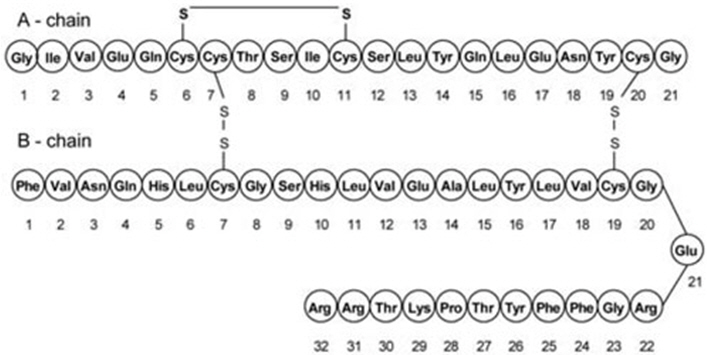
Lixisenatide
Lixisenatide is a synthetic analogue of human GLP-1 which acts as a GLP-1 receptor agonist. Lixisenatide is a peptide containing 44 amino acids, which is amidated at the C-terminal amino acid (position 44). The order of the amino acids is given in the figure below. Its molecular weight is 4858.5, and the empirical formula is C215H347N61O65S with the following chemical structure:
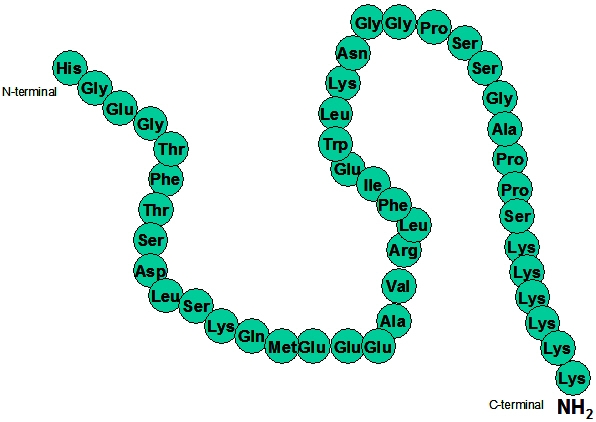
-
12 CLINICAL PHARMACOLOGY
12.1 Mechanism of Action
SOLIQUA 100/33
SOLIQUA 100/33 is a combination of insulin glargine, a basal insulin analog, and lixisenatide, a GLP-1 receptor agonist.
Insulin glargine
The primary activity of insulin, including insulin glargine, is regulation of glucose metabolism. Insulin and its analogs lower blood glucose by stimulating peripheral glucose uptake, especially by skeletal muscle and fat, and by inhibiting hepatic glucose production. Insulin inhibits lipolysis and proteolysis, and enhances protein synthesis.
12.2 Pharmacodynamics
Insulin Glargine
The combination of insulin glargine and lixisenatide has no impact on the pharmacodynamics of insulin glargine. The impact of the combination of insulin glargine and lixisenatide on the pharmacodynamics of lixisenatide has not been studied in phase 1 studies.
Lixisenatide
In a clinical pharmacology study in adults with type 2 diabetes mellitus, lixisenatide reduced fasting plasma glucose and postprandial blood glucose AUC0–300min compared to placebo (-33.8 mg/dL and -387 mg∙h/dL, respectively) following a standardized test meal. The effect on postprandial blood glucose AUC was most notable with the first meal, and the effect was attenuated with later meals in the day.
Treatment with lixisenatide 20 mcg once daily reduced postprandial glucagon levels (AUC0–300min) compared to placebo by -15.6 h∙pmol/L after a standardized test meal in patients with type 2 diabetes.
12.3 Pharmacokinetics
SOLIQUA 100/33
The insulin glargine/lixisenatide ratio has no relevant impact on the PK of insulin glargine in SOLIQUA 100/33.
Compared to administration of lixisenatide alone, the Cmax is lower whereas the AUC is generally comparable when administered as SOLIQUA 100/33. The insulin glargine/lixisenatide ratio has no impact on the PK of lixisenatide in SOLIQUA 100/33. The observed differences in the PK of lixisenatide when given as SOLIQUA 100/33 or alone are not considered to be clinically relevant.
Absorption
After subcutaneous administration of insulin glargine/lixisenatide combinations, insulin glargine showed no pronounced peak. Exposure to insulin glargine ranged from 86% to 101% compared to administration of insulin glargine alone.
After subcutaneous administration of insulin glargine/lixisenatide combinations, the median tmax of lixisenatide was in the range of 2.5 to 3.0 hours. There was a small decrease in Cmax of lixisenatide of 22%–34% compared with separate simultaneous administration of insulin glargine and lixisenatide, which is not likely to be clinically significant. There are no clinically relevant differences in the rate of absorption when lixisenatide is administered subcutaneously in the abdomen, thigh, or arm.
Metabolism and elimination
A metabolism study in humans who received insulin glargine alone indicates that insulin glargine is partly metabolized at the carboxyl terminus of the B chain in the subcutaneous depot to form two active metabolites with in vitro activity similar to that of human insulin, M1 (21A-Gly-insulin) and M2 (21A-Gly-des-30B-Thr-insulin). Unchanged drug and these degradation products are also present in the circulation.
Lixisenatide is presumed to be eliminated through glomerular filtration, and proteolytic degradation.
After multiple dose administration in patients with type 2 diabetes, mean terminal half-life was approximately 3 hours and the mean apparent clearance (CL/F) about 35 L/h.
Special populations
Effects of age, body weight, gender and race
Renal impairment
Lixisenatide: Compared to healthy subjects (N=4), plasma Cmax of lixisenatide was increased by approximately 60%, 42%, and 83% in subjects with mild (CLcr 60–89 mL/min [N=9]), moderate (CLcr 30–59 mL/min [N=11]), and severe (CLcr 15–29 mL/min [N=8]) renal impairment. Plasma AUC was increased by approximately 34%, 69% and 124% with mild, moderate, and severe renal impairment, respectively [see Use in Specific Populations (8.6)].
Drug interaction studies with SOLIQUA 100/33
Due to their peptidic nature, insulin glargine and lixisenatide have no relevant potential to induce or inhibit CYP isozymes and, therefore, no direct drug interaction is expected.
Beyond the interaction studies performed with the individual components no additional interaction studies were conducted with SOLIQUA 100/33.
Drug interaction studies with lixisenatide
The drug interaction studies focused on the potential for lixisenatide to influence the rate and extent of exposure to coadministered drugs due to its known delaying effect on gastric emptying.
Acetaminophen
Lixisenatide 10 mcg did not change the overall exposure (AUC) of acetaminophen following administration of a single dose of acetaminophen 1000 mg, whether before or after lixisenatide. No effects on acetaminophen Cmax and tmax were observed when acetaminophen was administered 1 hour before lixisenatide. When administered 1 or 4 hours after 10 mcg lixisenatide, Cmax of acetaminophen was decreased by 29% and 31%, respectively, and median tmax was delayed by 2.0 and 1.75 hours, respectively.
Oral contraceptives
Administration of a single dose of an oral contraceptive medicinal product (ethinylestradiol 0.03 mg/levonorgestrel 0.15 mg) 1 hour before or 11 hours after 10 mcg lixisenatide, did not change Cmax, AUC, t1/2 and tmax of ethinylestradiol and levonorgestrel.
Administration of the oral contraceptive 1 hour or 4 hours after lixisenatide did not affect the overall exposure (AUC) and mean terminal half-life (t1/2) of ethinylestradiol and levonorgestrel. However, Cmax of ethinylestradiol was decreased by 52% and 39%, respectively, and Cmax of levonorgestrel was decreased by 46% and 20%, respectively, and median tmax was delayed by 1 to 3 hours.
Atorvastatin
When lixisenatide 20 mcg and atorvastatin 40 mg were coadministered in the morning for 6 days, the exposure of atorvastatin was not affected, while Cmax was decreased by 31% and tmax was delayed by 3.25 hours. No such increase for tmax was observed when atorvastatin was administered in the evening and lixisenatide in the morning but the AUC and Cmax of atorvastatin were increased by 27% and 66%, respectively.
Warfarin and other coumarin derivatives
After concomitant administration of warfarin 25 mg with repeated dosing of lixisenatide 20 mcg, there were no effects on AUC or INR (International Normalized Ratio) while Cmax was reduced by 19% and tmax was delayed by 7 hours.
Digoxin
After concomitant administration of lixisenatide 20 mcg and digoxin 0.25 mg at steady state, the AUC of digoxin was not affected. The tmax of digoxin was delayed by 1.5 hour and the Cmax was reduced by 26%.
Ramipril
After concomitant administration of lixisenatide 20 mcg and ramipril 5 mg for 6 days, the AUC of ramipril was increased by 21% while the Cmax was decreased by 63%. The AUC and Cmax of the active metabolite (ramiprilat) were not affected. The tmax of ramipril and ramiprilat were delayed by approximately 2.5 hours.
-
13 NONCLINICAL TOXICOLOGY
13.1 Carcinogenesis, Mutagenesis, Impairment of Fertility
SOLIQUA 100/33
No animal studies have been conducted with the combination of insulin glargine and lixisenatide to evaluate carcinogenesis, mutagenesis, or impairment of fertility.
Insulin glargine
In mice and rats, standard two-year carcinogenicity studies with insulin glargine were performed at doses up to 0.455 mg/kg, which was for the rat approximately 2-times and for the mouse approximately 1-times the recommended human subcutaneous high dose of 60 units/day (0.0364 mg/kg/day), based on mg/m2. The findings in female mice were not conclusive due to excessive mortality in all dose groups during the study. Histiocytomas were found at injection sites in male rats (statistically significant) and male mice (not statistically significant) in acid vehicle containing groups. These tumors were not found in female animals, in saline control, or insulin comparator groups using a different vehicle. The relevance of these findings to humans is unknown.
Insulin glargine was not mutagenic in tests for detection of gene mutations in bacteria and mammalian cells (Ames- and HGPRT-test) and in tests for detection of chromosomal aberrations (cytogenetics in vitro in V79 cells and in vivo in Chinese hamsters).
In a combined fertility and prenatal and postnatal study with insulin glargine in male and female rats at subcutaneous doses up to 0.36 mg/kg/day, which was approximately 2-times the recommended human subcutaneous maximum dose of 60 units/day (0.0364 mg/kg/day), based on mg/m2, maternal toxicity due to dose-dependent hypoglycemia, including some deaths, was observed. Consequently, a reduction of the rearing rate occurred in the high-dose group only.
Lixisenatide
Carcinogenicity studies of 2-years durations were conducted in CD-1 mice and Sprague-Dawley rats with twice daily subcutaneous doses of 40, 200, or 1000 mcg/kg. A statistically significant increase in thyroid C-cell adenomas was observed in males at 2,000 mcg/kg/day, resulting in exposures that are >180-times the human exposure achieved at 20 mcg/day based on plasma AUC.
Statistically significant increases in thyroid C-cell adenomas were seen at all doses in rats, resulting in systemic exposures that are ≥15-times the human exposure achieved at 20 mcg/day based on plasma AUC. A numerical increase in thyroid C-cell carcinomas was observed in rats at ≥400 mcg/kg/day, resulting in systemic exposures that are ≥56-times the human exposure achieved at 20 mcg/day based on plasma AUC.
Mutagenesis
Lixisenatide was not mutagenic or clastogenic in a standard battery of genotoxicity tests (bacterial mutagenicity [Ames], human lymphocyte chromosome aberration, mouse bone marrow micronucleus).
Impairment of fertility
Studies in which male and female rats received twice daily subcutaneous doses lixisenatide of 2, 29, or 414 mcg/kg prior to pairing through gestation day 6 did not indicate any adverse effects on male or female fertility in rats up to the highest dose tested, 414 mcg/kg, or approximately 400-times the clinical systemic exposure at 20 mcg/day based on mcg/m2.
-
14 CLINICAL STUDIES
14.1 Overview of Clinical Studies
SOLIQUA 100/33 was evaluated in two randomized clinical studies in patients with type 2 diabetes mellitus. In each of the active-controlled trials, treatment with SOLIQUA 100/33 produced statistically significant improvements in HbA1c.
14.2 Clinical Study in Patients with Type 2 Diabetes Uncontrolled on OAD Treatment
A total of 1170 patients with type 2 diabetes were randomized in an open-label, 30-week, active-controlled study (Study A: NCT05058147) to evaluate the efficacy and safety of SOLIQUA 100/33 compared to the individual components, insulin glargine 100 units/mL and lixisenatide.
Patients with type 2 diabetes, treated with metformin alone or treated with metformin and a second OAD treatment that could be a sulfonylurea or a glinide or a sodium-glucose cotransporter-2 (SGLT-2) inhibitor or a dipeptidyl peptidase-4 (DPP-4) inhibitor, and who were not adequately controlled with this treatment (HbA1c range 7.5% to 10% for patients previously treated with metformin alone and 7% to 9% for patients previously treated with metformin and a second OAD treatment) entered a run-in period for 4 weeks. During this run-in period, metformin treatment was optimized and all other OADs were discontinued. At the end of the run-in period, patients who remained inadequately controlled (HbA1c between 7% and 10%) were randomized to either SOLIQUA 100/33 (n=469), insulin glargine 100 units/mL (n=467), or lixisenatide (n=234).
The type 2 diabetes population had the following characteristics: mean age was 58.4 years, 50.6% were male, 90.1% were Caucasian, 6.7% were Black or African American, and 19.1% were Hispanic. At screening, the mean duration of diabetes was approximately 9 years, the mean BMI was approximately 31.7 kg/m2, and mean eGFR was 84.8 mL/min/1.73 m2.
SOLIQUA 100/33 and insulin glargine were to be titrated weekly to target a fasting plasma glucose goal of <100 mg/dL. Patients could not increase their dose by more than 4 units per week and the prespecified maximum dose of insulin glargine was limited to 60 units. The targeted fasting plasma glucose goal was achieved in 35% of patients in both groups at 30 weeks.
At Week 30, SOLIQUA 100/33 provided statistically significant improvement in HbA1c (p-value <0.0001) compared to insulin glargine 100 units/mL and lixisenatide-treated patients (-1.6%, -1.3%, and -0.9%). In a prespecified analysis of this primary endpoint, the differences observed were consistent with regard to baseline OAD use (metformin alone or metformin plus second OAD).
The mean difference (95% CI) in HbA1c reduction between SOLIQUA 100/33 and insulin glargine was -0.3% (-0.4, -0.2) and -0.7% (-0.8, -0.6) compared to lixisenatide.
See Table 5 for the other endpoints in the study. The difference in the glucose lowering effect observed in the trial may not necessarily reflect the effect that will be observed in the care setting where insulin glargine dosage can be different than that used in the trial.
Table 5: Results at 30 Weeks – Add-On to Metformin Clinical Study SOLIQUA 100/33 Insulin Glargine 100 units/mL Lixisenatide - * Estimated using an ANCOVA with treatment, randomization strata, and country as fixed factors and baseline HbA1c as covariate. Twenty-six (5.5%) patients in the SOLIQUA 100/33 arm and 21 (4.5%) patients in the insulin glargine 100 units/mL arm, and 13 (5.6%) patients in the lixisenatide arm had missing HbA1c measurement at Week 30. Missing measurements were imputed using multiple imputations with respect to the baseline value of the subject.
- † The trial was designed to show the contribution of the GLP-1 component to glycemic lowering, and the insulin glargine dose and the dosing algorithm were selected to isolate the effect of the GLP-1 component. At the end of the trial, the doses of insulin glargine were equivalent between treatment groups. The mean final dose of SOLIQUA 100/33 at week 30 was 39.8 units (for SOLIQUA 100/33: 39.8 units insulin glargine/13.1 mcg lixisenatide) and 40.5 units in the insulin glargine–treated patients. The difference in effect observed in the trial may not necessarily reflect the effect that will be observed in the care setting where alternative insulin glargine dosage can be used.
- ‡ Lixisenatide was given at the maintenance dose of 20 mcg.
Number of subjects (randomized and treated) 469 467 233 HbA1c (%) Baseline (mean; post run-in phase) 8.1 8.1 8.1 End of study (mean) 6.5 6.8 7.3 LS change from baseline (mean)* -1.6 -1.3 -0.9 LS mean difference vs insulin glargine -0.3 [95% confidence interval] [-0.4, -0.2]† – (p-value) (<0.0001) LS mean difference vs lixisenatide -0.7 [95% confidence interval] – – [-0.8, -0.6]‡ (p-value) (<0.0001) Number of Patients (%) reaching HbA1c <7% at week 30 345 (74%) 277 (59%) 76 (33%) Fasting plasma glucose (mg/dL) Baseline (mean) 177.9 175.7 175.8 End of study (mean) 113.9 117.6 149.0 LS change from baseline (mean) -59.1 -55.8 -27.2 Figure 1: Mean HbA1c (%) Over Time – Randomized and Treated Population

S = Screening (Week 6), R = Run-in (Week 1), B = Baseline, MI = Multiple imputation.
INS/LIXI = fixed ratio combination, INS = Insulin Glargine, LIXI = Lixisenatide
Note: The plot included all scheduled measurements obtained during the study, including those obtained after IMP discontinuation or introduction of rescue medication.
30MI: Missing HbA1c values at Week 30 in each group were imputed using their baseline HbA1c values plus an error. The error is normally distributed with mean zero and a standard deviation set equal to the estimated pooled standard deviation.14.3 Clinical Studies in Patients with Type 2 Diabetes Uncontrolled on Basal Insulin
A total of 736 patients with type 2 diabetes participated in a randomized, 30-week, active-controlled, open-label, 2-treatment arm, parallel-group, multicenter study (Study B: NCT02058160) to evaluate the efficacy and safety of SOLIQUA 100/33 compared to insulin glargine 100 units/mL.
Patients screened had type 2 diabetes were treated with basal insulin for at least 6 months, receiving a stable daily dose of between 15 and 40 units alone or combined with 1 or 2 OADs (metformin, sulfonylurea, glinide, SGLT-2 inhibitor or a DPP-4 inhibitor), had an HbA1c between 7.5% and 10% and a FPG less than or equal to 180 mg/dL or 200 mg/dL depending on their previous antidiabetic treatment.
This type 2 diabetes population had the following characteristics: Mean age was 60 years, 46.7% were male, 91.7% were Caucasian, 5.2% were Black or African American and 17.9% were Hispanic. At screening, the mean duration of diabetes was approximately 12 years, the mean BMI was approximately 31 kg/m2, mean eGFR was 80.6 mL/min/1.73 m2 and 86.1% of patients had an eGFR ≥60 mL/min.
After screening, eligible patients (n=1018) entered a 6-week run-in phase where patients remained on or were switched to insulin glargine 100 units/mL, if they were treated with another basal insulin, and had their insulin glargine dose titrated/stabilized while continuing metformin (if previously taken). The mean HbA1c decreased during run-in period from 8.5% to 8.1%. Any other OADs were discontinued.
At the end of the run-in period, patients with an HbA1c between 7% and 10%, FPG ≤140 mg/dL and insulin glargine daily dose of 20 to 50 units (mean of 35 units), were randomized to either SOLIQUA 100/33 (n=367) or insulin glargine 100 units/mL (n=369).
SOLIQUA 100/33 and insulin glargine were to be titrated weekly to target a fasting plasma glucose goal of <100 mg/dL. The mean dose of insulin glargine at baseline was 35 units. The maximum dose of insulin glargine allowed in the trial was 60 units (insulin dose cap) in both groups. The targeted fasting plasma glucose goal was achieved in 33% of patients in both groups at 30 weeks.
At Week 30, there was a reduction in HbA1c from baseline of -1.1% for SOLIQUA 100/33 and -0.6% for insulin glargine 100 units/mL. The mean difference (95% CI) in HbA1c reduction between SOLIQUA 100/33 and insulin glargine was -0.5 [-0.6, -0.4] and statistically significant. The trial was designed to show the contribution of the GLP-1 component to glycemic lowering and the insulin glargine dose and the dosing algorithm was selected to isolate the effect of the GLP-1 component. At the end of the trial, the doses of insulin glargine were equivalent between treatment groups. The mean final dose of SOLIQUA 100/33 and insulin glargine at week 30 was 46.7 units (for SOLIQUA 100/33: 46.7 units insulin glargine/15.6 mcg lixisenatide). The difference in effect observed in the trial may not necessarily reflect the effect that will be observed in the care setting where alternative insulin glargine dosage can be used. See Table 6 for the other endpoints in the study.
Table 6: Results of a 30-Week Study in Patients with Type 2 Diabetes Mellitus Inadequately Controlled on Basal Insulin SOLIQUA 100/33 Insulin Glargine 100 units/mL - * Estimated using an ANCOVA with treatment, randomization strata, and country as fixed factors and baseline HbA1c as covariate. Twenty (5.5%) patients in the SOLIQUA 100/33 arm and 10 (2.7%) patients in the insulin glargine 100 units/mL arm had missing HbA1c measurement at Week 30. Missing measurements were imputed using multiple imputations with respect to the baseline value of the subject.
- † p<0.01; The trial was designed to show the contribution of the GLP-1 component to glucose lowering. The insulin glargine dose in this trial was capped at a maximum dose of 60 units and the dosing algorithm was selected to isolate the effect of the GLP-1 component. At the end of the trial, the doses of insulin glargine were equivalent between treatment groups. The mean final dose of SOLIQUA 100/33 and insulin glargine at week 30 was 46.7 units (for SOLIQUA 100/33: 46.7 units insulin glargine/15.6 mcg lixisenatide). The difference in effect observed in the trial may not necessarily reflect the effect that will be observed in the care setting where alternative insulin glargine dosage can be used.
- ‡ Patients with missing HbA1c measurement at Week 30 were considered non-responders.
Number of subjects (randomized and treated) 365 365 HbA1c (%) Baseline (mean; post run-in phase) 8.1 8.1 End of study (mean) 6.9 7.5 LS change from baseline (mean)* -1.1 -0.6 Difference vs insulin glargine -0.5 [95% confidence interval] [-0.6, -0.4]† Patients [n (%)] reaching HbA1c <7% at week 30‡ 201 (55.1%) 108 (29.6%) Fasting plasma glucose (mg/dL) Baseline (mean) 132.3 132.0 End of study (mean) 121.9 120.5 LS change from baseline (mean) -5.7 -7.0 -
16 HOW SUPPLIED/STORAGE AND HANDLING
16.1 How Supplied
SOLIQUA 100/33 is an injection supplied as a sterile, clear, colorless to almost colorless solution in a 3 mL prefilled, disposable, single-patient-use pen injector:
Dosage Unit/Strength Package size NDC # 3 mL SOLIQUA 100/33 single-patient-use prefilled pen
100 units/mL insulin glargine and 33 mcg/mL lixisenatidePackage of 5 0024-5761-05 Needles are not included. Only use needles that are compatible for use with SOLIQUA 100/33 prefilled pen.
16.2 Storage
Dispense in the original sealed carton with the enclosed Instructions for Use.
Prior to first use, SOLIQUA 100/33 pen should be stored in a refrigerator, 36°F–46°F (2°C–8°C). Do not freeze. Protect from light. Discard after the expiration date printed on the label.
SOLIQUA 100/33 should not be stored in the freezer and should not be allowed to freeze. Discard SOLIQUA 100/33 if it has been frozen.
After first use, store at room temperature below 77°F (25°C). Replace the pen cap after each use to protect from light.
Discard pen 28 days after first use.
Always remove the needle after each injection and store the SOLIQUA 100/33 pen without a needle attached. This prevents contamination and/or infection, or leakage of the SOLIQUA 100/33 pen, and will ensure accurate dosing. Always use a new needle for each injection to prevent contamination.
-
17 PATIENT COUNSELING INFORMATION
Advise the patient to read the FDA-approved patient labeling (Medication Guide and Instructions for Use).
Hypersensitivity Reactions
Inform patients that serious hypersensitivity reactions, including anaphylaxis, have been reported in clinical trials of SOLIQUA 100/33 and during postmarketing use of other GLP-1 receptor agonists. If symptoms of hypersensitivity reactions occur, instruct patients to stop taking SOLIQUA 100/33 and seek medical advice promptly [see Warnings and Precautions (5.1)].
Risk of Pancreatitis
Inform patients that persistent severe abdominal pain that may radiate to the back and which may or may not be accompanied by vomiting is the hallmark symptom of acute pancreatitis. Instruct patients to promptly discontinue SOLIQUA 100/33 and contact their physician if persistent severe abdominal pain occurs [see Warnings and Precautions (5.2)].
Never Share a SOLIQUA 100/33 Pen
Advise patients that they must never share a SOLIQUA 100/33 prefilled pen with another person, even if the needle is changed because doing so carries a risk for transmission of blood-borne pathogens [see Warnings and Precautions (5.3)].
Hyperglycemia or Hypoglycemia
Inform patients that hypoglycemia is the most common adverse reaction with insulin-containing products. Inform patients of the symptoms of hypoglycemia. Inform patients that the ability to concentrate and react may be impaired as a result of hypoglycemia [see Warnings and Precautions (5.6)]. This may present a risk in situations where these abilities are especially important, such as driving or operating other machinery. Advise patients who have frequent hypoglycemia or reduced or absent warning signs of hypoglycemia to use caution when driving or operating machinery.
Advise patients that changes in insulin regimen can predispose to hyperglycemia or hypoglycemia and that changes in insulin regimen should be made under close medical supervision [see Warnings and Precautions (5.4)].
Dehydration and Renal Failure
Advise patients treated with SOLIQUA 100/33 of the potential risk of dehydration due to gastrointestinal adverse reactions and to take precautions to avoid fluid depletion. Inform patients of the potential risk for worsening renal function, which in some cases may require dialysis [see Warnings and Precautions (5.7)].
Overdose due to Medication Errors
Inform patients that SOLIQUA 100/33 contains two drugs: insulin glargine and lixisenatide. Accidental mix-ups between insulin products have been reported. To avoid medication errors between SOLIQUA 100/33 and other insulin products, instruct patients to always check the label before each injection. Advise patients that the administration of more than 60 units of SOLIQUA 100/33 daily can result in overdose of the lixisenatide component. Instruct patients not to administer concurrently with other glucagon-like peptide-1 receptor agonists [see Warnings and Precautions (5.5)].
Use in Pregnancy
Advise patients to inform their physicians if they are pregnant or intend to become pregnant [see Use in Specific Populations (8.1)].
- SPL UNCLASSIFIED SECTION
-
MEDICATION GUIDE
This Medication Guide has been approved by the U.S. Food and Drug Administration Revised: November 2019 Medication Guide
SOLIQUA® 100/33 (So - lee - kwa)
(insulin glargine and lixisenatide injection)
for subcutaneous useWhat is the most important information I should know about SOLIQUA 100/33?
Do not share your SOLIQUA 100/33 pen with other people, even if the needle has been changed. You may give other people a serious infection, or get a serious infection from them.
SOLIQUA 100/33 can cause serious side effects including inflammation of the pancreas (pancreatitis), which may be severe and lead to death.
Before using SOLIQUA 100/33, tell your healthcare provider if you have had:- pancreatitis
- stones in your gallbladder (cholelithiasis)
- a history of alcoholism
These medical problems may make you more likely to get pancreatitis.
Stop taking SOLIQUA 100/33 and call your healthcare provider right away if you have pain in your stomach area (abdomen) that is severe and will not go away. The pain may be felt going from your abdomen through to your back. The pain may happen with or without vomiting. These may be symptoms of pancreatitis.What is SOLIQUA 100/33?
SOLIQUA 100/33 is an injectable prescription medicine that contains 2 diabetes medicines, insulin glargine and lixisenatide, which may improve blood sugar (glucose) control in adults with type 2 diabetes when used with diet and exercise.- SOLIQUA 100/33 has not been studied in people with a history of pancreatitis.
- SOLIQUA 100/33 is not recommended for people who also take lixisenatide or other medicines called GLP-1 receptor agonists.
- SOLIQUA 100/33 is not for use in people with type 1 diabetes or people with diabetic ketoacidosis.
- SOLIQUA 100/33 has not been studied in people who have a stomach problem that causes slow emptying of the stomach (gastroparesis). SOLIQUA 100/33 is not for people with slow emptying of the stomach.
- SOLIQUA 100/33 has not been studied in people who also take a short-acting (prandial) insulin.
- It is not known if SOLIQUA 100/33 is safe and effective in children under 18 years of age.
Who should not use SOLIQUA 100/33?
Do not use SOLIQUA 100/33 if you:- are having an episode of low blood sugar (hypoglycemia).
- are allergic to insulin glargine, lixisenatide or any of the other ingredients in SOLIQUA 100/33. See the end of this Medication Guide for a complete list of ingredients in SOLIQUA 100/33.
Symptoms of a severe allergic reaction with SOLIQUA 100/33 may include:
- swelling of the face, lips, tongue, or throat
- problems breathing or swallowing
- severe rash or itching
- fainting or feeling dizzy
- very rapid heartbeat
- low blood pressure
Before using SOLIQUA 100/33, tell your healthcare provider about all your medical conditions including if you: - have or have had symptoms of acute pancreatitis, stones in your gallbladder, or a history of alcoholism.
- have or have had liver or kidney problems.
- have heart failure or other heart problems. If you have heart failure, it may get worse while you take thiazolidinediones (TZDs).
- have severe problems with your stomach, such as slowed emptying of your stomach (gastroparesis) or problems with digesting food.
- are taking certain medicines called glucagon-like peptide-1 receptor agonists (GLP-1 receptor agonists).
- have had an allergic reaction to a GLP-1 receptor agonist medicine.
- are pregnant or plan to become pregnant. It is not known if SOLIQUA 100/33 will harm your unborn baby. Tell your healthcare provider if you are pregnant or plan to become pregnant while using SOLIQUA 100/33.
- are breastfeeding or plan to breastfeed. It is not known if SOLIQUA 100/33 passes into your breast milk. Talk with your healthcare provider about the best way to feed your baby while you use SOLIQUA 100/33.
Know the medicines you take. Keep a list of them to show your healthcare provider and pharmacist each time you get a new medicine.How should I use SOLIQUA 100/33? - Read the detailed Instructions for Use that comes with SOLIQUA 100/33 for instructions on using the SOLIQUA 100/33 pen and injecting SOLIQUA 100/33.
- Use SOLIQUA 100/33 exactly as your healthcare provider tells you to.
- Do not change your dose unless your healthcare provider has told you to change your dose.
- Your healthcare provider should teach you how to inject SOLIQUA 100/33 before you use it for the first time. If you have questions or do not understand the instructions, talk to your healthcare provider.
- Take SOLIQUA 100/33 only 1 time each day within 1 hour before the first meal of the day.
- If you miss a dose of SOLIQUA 100/33, take your next scheduled dose at your regular time. Do not take an extra dose or increase your dose to make up for the missed dose.
- Check the label on the SOLIQUA 100/33 pen each time you give your injection to make sure you are using the correct medicine.
- Do not take more than 60 units of SOLIQUA 100/33 each day. SOLIQUA 100/33 contains two medicines: insulin glargine and lixisenatide. If you take too much SOLIQUA 100/33, it can cause severe nausea and vomiting. Do not take SOLIQUA 100/33 with other GLP-1 receptor agonists. If you take too much SOLIQUA 100/33, call your healthcare provider or go to the nearest hospital emergency room right away.
- Only use SOLIQUA 100/33 that is clear, colorless to almost colorless. If you see small particles, return it to your pharmacy for a replacement.
- Inject your dose of SOLIQUA 100/33 under the skin (subcutaneously) of your abdomen, thigh or upper arm. Do not use SOLIQUA 100/33 in an insulin pump or inject SOLIQUA 100/33 into your vein (intravenously) or muscle (intramuscularly).
-
Change (rotate) your injection site within the area you choose with each dose to reduce your risk of getting lipodystrophy (pits in skin or thickened skin) and localized cutaneous amyloidosis (skin with lumps) at the injection sites.
- Do not use the exact same spot for each injection.
- Do not inject where the skin has pits, is thickened, or has lumps.
- Do not inject where the skin is tender, bruised, scaly or hard, or into scars or damaged skin.
- Do not mix SOLIQUA 100/33 in any other type of insulin or liquid medicine prior to injection.
- Do not remove SOLIQUA 100/33 from the throw away (disposable) prefilled pen with a syringe.
- Do not reuse or share your needles with other people. You may give other people a serious infection, or get a serious infection from them.
- Check your blood sugar levels. Ask your healthcare provider what your blood sugar should be and when you should check your blood sugar levels.
What are the possible side effects of SOLIQUA 100/33?
SOLIQUA 100/33 may cause serious side effects including:- See "What is the most important information I should know about SOLIQUA 100/33?"
- Severe allergic reactions. Severe allergic reactions can happen with SOLIQUA 100/33. Stop taking SOLIQUA 100/33 and get medical help right away if you have any symptoms of a severe allergic reaction. See "Who should not use SOLIQUA 100/33?"
- Low blood sugar (hypoglycemia). Your risk for getting low blood sugar is higher if you take another medicine that can cause low blood sugar. Signs and symptoms of low blood sugar include:
- headache
- weakness
- fast heartbeat
- dizziness
- irritability
- feeling jittery
- drowsiness
- hunger
- confusion
- sweating
- blurred vision
- anxiety
Talk with your healthcare provider about how to treat low blood sugar. - Kidney problems (kidney failure). In people who have kidney problems, the occurrence of diarrhea, nausea, and vomiting may cause a loss of fluids (dehydration) which may cause kidney problems to get worse.
- Low potassium in your blood (hypokalemia).
- Heart failure. Taking certain diabetes pills called TZDs with SOLIQUA 100/33 may cause heart failure in some people. This can happen even if you have never had heart failure or heart problems before. If you already have heart failure it may get worse while you take TZDs with SOLIQUA 100/33. Your healthcare provider should monitor you closely while you are taking TZDs with SOLIQUA 100/33. Tell your healthcare provider if you have any new or worse symptoms of heart failure including shortness of breath, swelling of your ankles or feet, or sudden weight gain. Treatment with TZDs and SOLIQUA 100/33 may need to be adjusted or stopped by your healthcare provider if you have new or worse heart failure.
- low blood sugar (hypoglycemia)
- nausea
- stuffy or runny nose and sore throat
- diarrhea
- upper respiratory tract infection
- headache
Nausea and diarrhea usually happen more often when you first start using SOLIQUA 100/33.
These are not all the possible side effects of SOLIQUA 100/33. Call your doctor for medical advice about side effects. You may report side effects to FDA at 1-800-FDA-1088.How should I store SOLIQUA 100/33? - Store your new, unused SOLIQUA 100/33 pen in the refrigerator at 36°F to 46°F (2°C to 8°C). Protect the pen from light.
- After first use, store your SOLIQUA 100/33 pen at room temperature no higher than 77°F (25°C).
- Do not freeze SOLIQUA 100/33 pens and do not use SOLIQUA 100/33 if it has been frozen.
- Replace the pen cap after each use to protect from light.
- After first use, use the SOLIQUA 100/33 pen for up to 28 days. Throw away the used SOLIQUA 100/33 pen after 28 days, even if there is some medicine left in the pen.
- Do not use SOLIQUA 100/33 past the expiration date printed on the carton and pen label.
- Do not store the SOLIQUA 100/33 pen with the needle attached. If the needle is left on, this might lead to contamination and cause air bubbles which might affect your dose of medicine.
- See the Instructions for Use about the right way to throw away the SOLIQUA 100/33 pen.
- Keep your SOLIQUA 100/33 pen, pen needles, and all medicines out of the reach of children.
General information about the safe and effective use of SOLIQUA 100/33.
Medicines are sometimes prescribed for purposes other than those listed in a Medication Guide. Do not use SOLIQUA 100/33 for a condition for which it was not prescribed. Do not give SOLIQUA 100/33 to other people, even if they have the same symptoms that you have. It may harm them.
You can ask your pharmacist or healthcare provider for information about SOLIQUA 100/33 that is written for health professionals.What are the ingredients in SOLIQUA 100/33?
Active ingredients: insulin glargine and lixisenatide
Inactive ingredients: 3 mg of methionine, 2.7 mg of metacresol, 20 mg of glycerol, 30 mcg of zinc, hydrochloric acid, sodium hydroxide and water for injection.sanofi-aventis U.S. LLC, Bridgewater, NJ 08807 A SANOFI COMPANY
For more information, go to www.soliqua100-33.com or call sanofi-aventis at 1-800-633-1610. -
INSTRUCTIONS FOR USESOLIQUA® 100/33 (So - lee - kwa)
(insulin glargine and lixisenatide injection) for subcutaneous use
Read these instructions carefully before using your SOLIQUA 100/33 pen.
Do not share your SOLIQUA 100/33 pen with other people, even if the needle has been changed. You may give other people a serious infection, or get a serious infection from them.
SOLIQUA 100/33 is an injectable prescription medicine that contains 2 diabetes medicines, insulin glargine and lixisenatide in a SoloStar pen. The drug combination in this pen is only for the daily injection of 15 to 60 units of SOLIQUA 100/33. Each unit dialed contains 1 unit insulin glargine and 0.33 mcg lixisenatide.
Important information
- Check the label on the SOLIQUA 100/33 pen each time you give your injection to make sure you are using the correct medicine.
- Do not use your pen if it is damaged or if you are not sure that it is working correctly.
- Perform a safety test before each injection (see "Step 3: Do a safety test").
- Always carry a spare pen and spare needles in case they are lost or stop working.
- Do not reuse needles. Always use a new sterile needle for each injection. This helps stop blocked needles, contamination, and infection. If you reuse needles, you might not get your dose (underdosing) or get too much (overdosing).
- Do not use SOLIQUA 100/33 in an insulin pump or inject SOLIQUA 100/33 into your vein (intravenously) or muscle (intramuscularly).
- Do not mix SOLIQUA 100/33 in any other type of insulin or liquid medicine prior to injection.
- Change (rotate) your injection sites within the area you chose with each dose (see "Places to inject").
Learn to inject
- Talk with your healthcare provider about how to use the SOLIQUA 100/33 pen and how to inject correctly before using your pen.
- Ask for help if you have problems handling the pen, for example if you have vision problems.
- Read all of these instructions before using your pen. You may get too much or too little medicine if you do not follow the instructions correctly.
Need help?
If you have any questions about your pen or about diabetes, ask your healthcare provider, go to www.soliqua100-33.com or call sanofi-aventis at 1-800-633-1610.
Supplies you will need:
- 1 SOLIQUA 100/33 pen
- 1 new sterile needle (see Step 2 "Attach a new needle")
- 1 alcohol swab
- a puncture-resistant container for used needles and pens (see "Throwing your pen away" at the end of this Instructions for Use)
- Inject your SOLIQUA 100/33 dose exactly as your healthcare provider has shown you.
- Inject your SOLIQUA 100/33 dose under the skin (subcutaneously) of your upper legs (thighs), upper arms, or stomach area (abdomen).
- Change (rotate) your injection sites within the area you choose for each dose to reduce your risk of getting lipodystrophy (pits in skin or thickened skin) and localized cutaneous amyloidosis (skin with lumps) at the injection sites.
- Do not inject where the skin has pits, is thickened, or has lumps.
- Do not inject where the skin is tender, bruised, scaly or hard, or into scars or damaged skin.
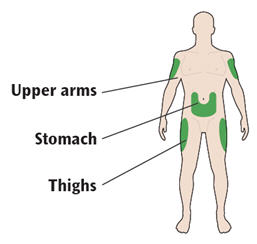

Step 1: Check your pen
Take a new pen out of the refrigerator at least 1 hour before you inject. Cold medicine is more painful to inject.
- 1A
Check the name and expiration date on the label of your pen.
- Make sure you have the correct medicine. This pen is colored light green with an orange injection button (see the "Get to know your pen" diagram).
- Do not use your pen after the expiration date on the pen label.
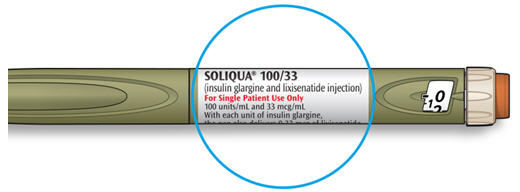
- 1B Pull off the pen cap.

- 1C
Check that the medicine is clear and colorless to almost colorless.
- If you see small particles, return it to your pharmacy for a replacement.

- 1D Wipe the rubber seal with an alcohol swab.
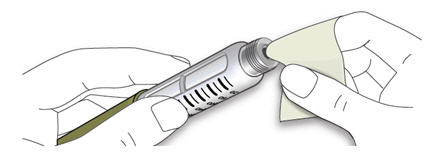
If you have other injector pens
- Making sure you have the correct medicine is especially important if you have other injector pens.
- Do not reuse needles. Always use a new sterile needle for each injection. This helps stop blocked needles, contamination and infection.
- Only use needles that are meant to be used with SOLIQUA 100/33. Needles are supplied separately. If you do not know what needles to use, ask your healthcare provider or pharmacist.
- 2A Take a new needle and peel off the protective seal.

- 2B Keep the needle straight and screw it onto the pen until fixed. Do not over-tighten.
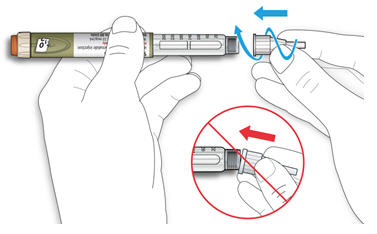
- 2C Pull off the outer needle cap. Keep this for later.
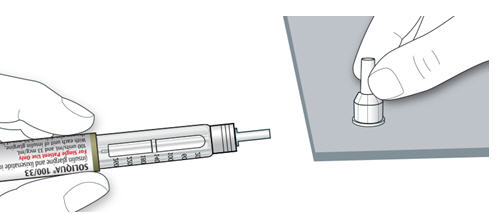
- 2D Pull off the inner needle cap and throw it away.
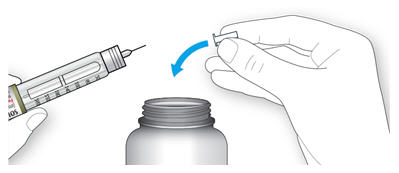
Handling needles
- Take care when handling needles to prevent needle-stick injury and cross-infection.
Perform a safety test before each injection to:
- Check your pen and the needle to make sure they are working properly.
- Make sure that you get the correct dose.

- 3B
Press the injection button all the way in.
- When the medicine comes out of the needle tip, your pen is working correctly.
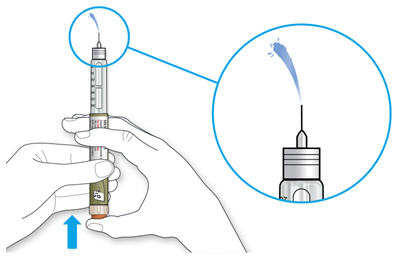
If no liquid appears:
- You may need to repeat this step up to 3 times before seeing the medicine.
- If no medicine comes out after the third time, the needle may be blocked. If this happens:
- Do not use your pen if still no medicine comes out of the needle tip. Use a new pen.
- Do not use a syringe to remove medicine from your pen.
If you see air bubbles
- You may see air bubbles in the medicine. This is normal, they will not harm you.
Step 4: Select the dose
- Do not select a dose or press the injection button without a needle attached. This may damage your pen.
- Only use this pen to inject your daily dose from 15 to 60 units. Do not change your dose unless your healthcare provider has told you to change your dose.
- Do not use this pen if you need a single daily dose that is more than 60 units.
- Do not use the pen if your single daily dose is less than 15 units, the black area in dose window as shown in the picture.
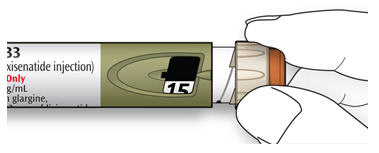
- 4A Make sure a needle is attached and the dose is set to '0'.

- 4B
Turn the dose selector until the dose pointer lines up with your dose.
- Do not dial your dose by counting the clicks, because you might dial the wrong dose. Always check the number in the dose window to make sure you dialed the correct dose.
- If you turn past your dose, you can turn back down.
- If there are not enough units left in your pen for your dose, the dose selector will stop at the number of units left.
- If you cannot select your full prescribed dose, use a new pen.
How to read the dose window
- Each line in the dose window equals 1 unit of SOLIQUA 100/33.
- Even numbers are shown in line with the dose pointer, as shown in picture.
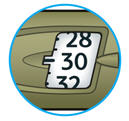 30 units selected
30 units selected- Odd numbers are shown as a line between even numbers, as shown in picture.
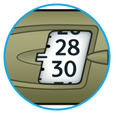 29 units selected
29 units selectedUnits of medicine in your pen
- This pen contains 300 units of SOLIQUA 100/33 and it is intended to be used for more than one dose.
Step 5: Inject your dose
If you find it hard to press the injection button in, do not force it as this may break your pen. See the section after Step 5E below for help.
- 5A
Choose a place to inject as shown in the picture labeled "Places to inject."
- 5B Push the needle into your skin as shown by your healthcare provider.
- Do not touch the injection button yet.
- 5B Push the needle into your skin as shown by your healthcare provider.
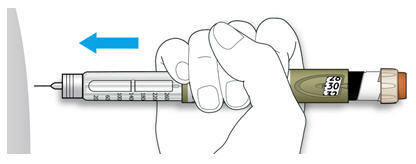
- 5C
Place your thumb on the injection button. Then press all the way in and hold.
- Do not press injection button at an angle. Your thumb could block the dose selector from turning.
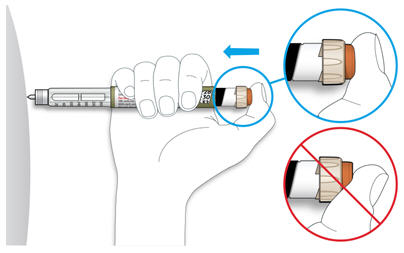
- 5D
Keep the injection button held in and when you see "0" in the dose window, slowly count to 10.
- This will make sure you get your full dose.
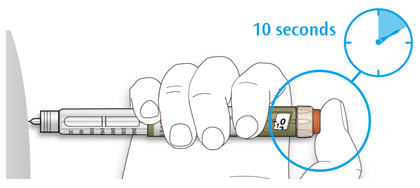
- 5E After holding and slowly counting to 10, release the injection button. Then remove the needle from your skin.
If you find it hard to press the injection button in:
- Change the needle (see Step 6 to remove the needle and Step 2 to attach a new needle) then do a safety test (see Step 3).
- If you still find it hard to press in, get a new pen.
- Do not use a syringe to remove medicine from your pen.
- Take care when handling needles to prevent needle-stick injury and cross-infection.
- Do not put the inner needle cap back on.
- 6A
Grip the widest part of the outer needle cap. Keep the needle straight and guide it into the outer needle cap back. Then push firmly on.
- The needle can puncture the cap if it is recapped at an angle.
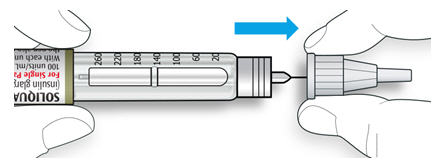
- 6B
Grip and squeeze the widest part of the outer needle cap. Turn your pen several times with your other hand to remove the needle.
- Try again if the needle does not come off the first time.
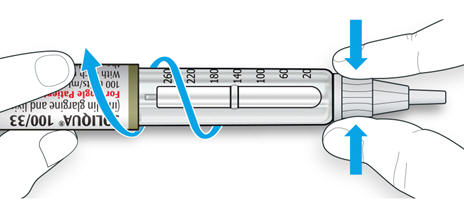
- 6C Throw away the used needle in a puncture-resistant container (see "Throwing your pen away" at the end of this Instructions for Use).
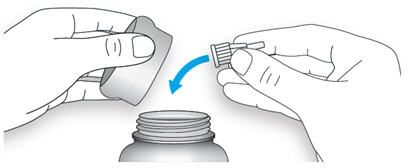
- 6D
Put your pen cap back on.
- Do not put the pen back in the refrigerator.

Use by
- Only use your pen for up to 28 days after its first use.
How to store your pen
Before first use
- Keep new pens in the refrigerator between 36°F to 46°F (2°C to 8°C).
- Do not freeze. If you accidentally freeze your pen, throw it away.
After first use
- Keep your pen at room temperature, below 77°F (25°C).
- Do not put your pen back in the refrigerator.
- Do not store your pen with the needle attached.
- Store the pen with your pen cap on.
Keep this pen out of the sight and reach of children.
How to care for your pen
Handle your pen with care
- Do not drop your pen or knock it against hard surfaces.
- If you think that your pen may be damaged, do not try to fix it. Use a new one.
Protect your pen from dust and dirt
- You can clean the outside of your pen by wiping it with a damp cloth (water only). Do not soak, wash or lubricate the pen. This may damage it.
- Put the used SOLIQUA 100/33 pen in a FDA-cleared sharps disposal container right away after use. Do not throw away (dispose of) the SOLIQUA 100/33 pen in your household trash.
- If you do not have a FDA-cleared sharps disposal container, you may use a household container that is:
- made of a heavy-duty plastic,
- can be closed with a tight-fitting, puncture-resistant lid, without sharps being able to come out,
- upright and stable during use,
- leak-resistant, and
- properly labeled to warn of hazardous waste inside the container.
- When your sharps disposal container is almost full, you will need to follow your community guidelines for the right way to dispose of your sharps disposal container. There may be state or local laws about how you should throw away used needles and syringes. For more information about safe sharps disposal, and for specific information about sharps disposal in the state that you live in, go to the FDA's website at: http://www.fda.gov/safesharpsdisposal
This Instructions for Use has been approved by the U.S. Food and Drug Administration.
Revised: November 2019
sanofi-aventis U.S. LLC
Bridgewater, NJ 08807
A SANOFI COMPANY© 2019 sanofi-aventis U.S. LLC
SOLIQUA and SoloStar are registered trademarks of sanofi-aventis U.S. LLC.
-
PRINCIPAL DISPLAY PANEL - 5 Pen Carton
NDC: 0024-5761-05
Rx ONLYSOLIQUA® 100/33
(insulin glargine and lixisenatide injection)
For Single Patient Use Only
100 units/mL and 33 mcg/mL
With each unit of insulin glargine,
the pen also delivers 0.33 mcg of lixisenatide
Only for Doses from 15 to 60 UnitsSolution for injection in a SoloStar® disposable insulin delivery device
Never remove medication using a syringe
Do not mix with other insulins
For subcutaneous injection only
Use only if solution is clear and colorless with no particles visible*Needles not included (see back panel)
Five 3 mL prefilled pens (15 mL total) – Dispense in this sealed carton
Dispense with the medication guideSANOFI
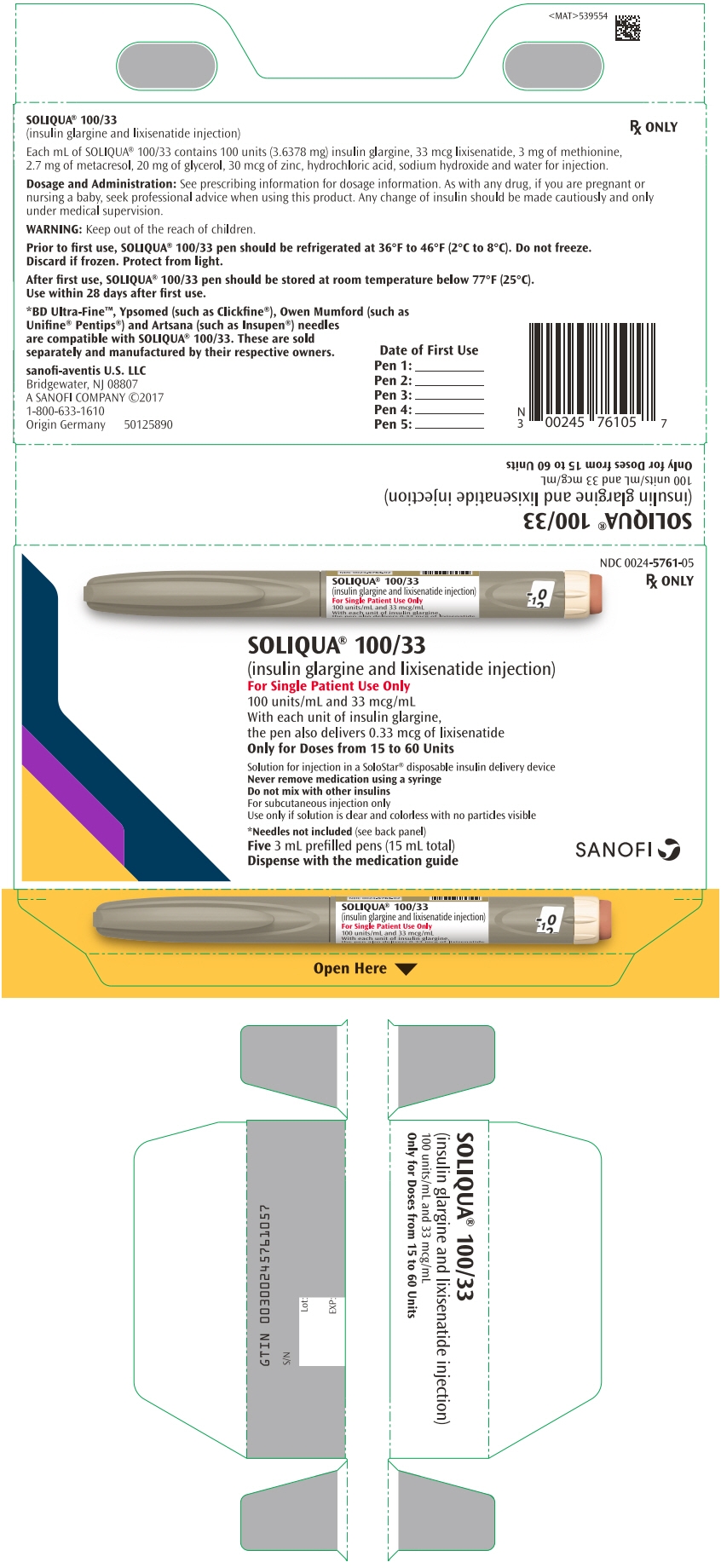
-
INGREDIENTS AND APPEARANCE
SOLIQUA 100/33
insulin glargine and lixisenatide injection, solutionProduct Information Product Type HUMAN PRESCRIPTION DRUG Item Code (Source) NDC: 0024-5761 Route of Administration SUBCUTANEOUS Active Ingredient/Active Moiety Ingredient Name Basis of Strength Strength INSULIN GLARGINE (UNII: 2ZM8CX04RZ) (INSULIN GLARGINE - UNII:2ZM8CX04RZ) INSULIN GLARGINE 100 U in 1 mL LIXISENATIDE (UNII: 74O62BB01U) (LIXISENATIDE - UNII:74O62BB01U) LIXISENATIDE 33 ug in 1 mL Inactive Ingredients Ingredient Name Strength ZINC CHLORIDE (UNII: 86Q357L16B) METACRESOL (UNII: GGO4Y809LO) GLYCERIN (UNII: PDC6A3C0OX) WATER (UNII: 059QF0KO0R) METHIONINE (UNII: AE28F7PNPL) Packaging # Item Code Package Description Marketing Start Date Marketing End Date 1 NDC: 0024-5761-05 5 in 1 CARTON 11/21/2016 1 NDC: 0024-5761-02 3 mL in 1 SYRINGE; Type 2: Prefilled Drug Delivery Device/System (syringe, patch, etc.) 2 NDC: 0024-5761-01 1 in 1 CARTON 11/21/2016 2 3 mL in 1 SYRINGE; Type 2: Prefilled Drug Delivery Device/System (syringe, patch, etc.) Marketing Information Marketing Category Application Number or Monograph Citation Marketing Start Date Marketing End Date BLA BLA208673 11/21/2016 Labeler - Sanofi-Aventis U.S. LLC (824676584) Establishment Name Address ID/FEI Business Operations Sanofi-Aventis Deutschland GmbH 313218430 ANALYSIS(0024-5761) , API MANUFACTURE(0024-5761) , LABEL(0024-5761) , MANUFACTURE(0024-5761) , PACK(0024-5761)
© 2025 FDA.report
This site is not affiliated with or endorsed by the FDA.